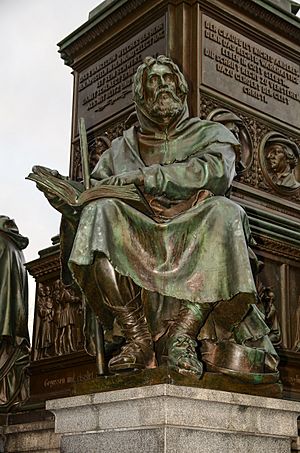Peter Waldo facts for kids
Quick facts for kids
Peter Waldo
|
|
|---|---|

Statue of Peter Waldo at the Luther Monument in Worms, Germany
|
|
| Born | c. 1140 Possibly Lyon, France
|
| Died | c. 1205 (age about 65) |
| Occupation | Spiritual leader, theologian, merchant |
| Theological work | |
| Tradition or movement | Waldensian |
Peter Waldo (born around 1140 – died around 1205) was an important Christian leader in the Middle Ages. He started a spiritual group called the Waldensians.
Some historians believe his first name, "Peter," might have been added later. He is seen as a "Proto-Protestant," meaning he had ideas similar to those who later started the Protestant Reformation.
Contents
Who Were the Waldensians?
Many historians, like Jana Schulman, believe Peter Waldo founded the Waldensians. This happened sometime between 1170 and 1177.
However, some people claimed the Waldensians existed even before Waldo. For example, a writer named Bernard said they appeared during the time of Pope Lucius. Another writer, Eberard de Béthune, thought the name Vaudois meant "valley dwellers." He said this name was used before Peter Waldo.
For a long time, people believed Waldo didn't start a new group. They thought he was just continuing a pure form of Christianity. This faith was supposedly started by the Apostles in the Alps, soon after Jesus went to heaven.
Peter Waldo's Life and Teachings
Most details about Peter Waldo's life are not known. We do know he was a rich cloth seller and merchant from Lyon, France. He was also quite educated.
Waldo wanted to understand the Bible better. So, he hired monks to translate it for him. They translated the New Testament into the local language, called "Romance" or Franco-Provençal. This was one of the first times the Bible was available in a modern language other than Latin in Europe.
Reading the Bible made Waldo very interested in being pure and perfect. In 1173, he heard a singer tell the story of Saint Alexius. Alexius was a saint who gave up his wealth to live a poor life, just like Jesus. This story inspired Waldo greatly.
Waldo then decided to live in poverty. He sold everything he owned. He gave money to the poor and put his two young daughters into a convent. He also gave property to his wife.
Waldo began traveling around Lombardy, a region in Italy. He begged for food and preached about how important poverty was. Lombardy was a place where many new religious ideas were spreading. Some of these ideas were later called heresies by the Catholic Church.
Waldo gathered many followers. They were called the Poor of Lyons, the Poor of Lombardy, or the Poor of God. They traveled around like sellers, sharing their teachings. This group became known as the Waldensians.
The Waldensian movement was special from the start. Its followers believed that ordinary people could preach. They also believed in voluntary poverty and strictly following the Bible. Unlike other religious leaders, Waldo had never been a Catholic priest.
Challenges and Persecution
In January 1179, Waldo and one of his followers went to Rome. They met with Pope Alexander III and other Church leaders. They talked about their beliefs, like how everyone could be a priest and how the Bible should be in the local language. They also discussed their choice to live in poverty.
The Pope agreed with their vow of poverty. However, he told them they could not preach because they were not priests. But Waldo and his followers did not listen. They continued to preach and gain more followers.
They started teaching ideas that were different from the Catholic Church. For example, they believed that all good people, including women, could preach without the Church's permission. They also spoke against ideas like Purgatory, prayers for the dead, and indulgences.
Because of this, the Catholic Church officially removed them from the Church. This is called excommunication. By the late 1180s, the Waldensians were seen as heretics. This made them preach even more against the Roman Catholic Church.
The Waldensians also developed beliefs against using weapons or making oaths. This meant they refused to take part in some Catholic ceremonies. The Church accused them of turning away from their faith.

Waldo spoke out against what he saw as wrong actions by the Pope and some Catholic teachings. These included the idea of purgatory and transubstantiation.
In March 1179, Waldo's ideas were condemned at the Third Council of the Lateran. However, the Waldensian leaders themselves were not yet excommunicated.
In 1180, Waldo wrote down his beliefs in a statement of faith.
After being forced to leave Lyon, Waldo and his followers moved to the valleys of Piedmont in Italy and the Luberon region in France. They continued to follow Christianity based on the New Testament.
Finally, in 1184, Pope Lucius III officially excommunicated Waldo. This happened at a meeting in Verona. The beliefs of the Poor of Lyons were again condemned in 1215 at the Fourth Council of the Lateran. This time, the group was named, and their ideas were declared heresy.
To escape being stopped by the Church, Waldo's followers fled to the mountains of northern Italy. There, they formed the Waldensian Evangelical Church.
See also
 In Spanish: Pedro Valdo para niños
In Spanish: Pedro Valdo para niños
- Waldensians
- Waldensian Evangelical Church
- John Charles Beckwith
- Luserna San Giovanni
- Val Pellice
- Waldensian valleys

